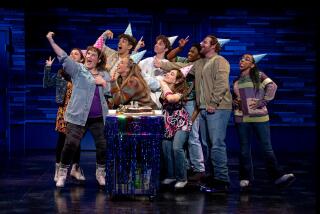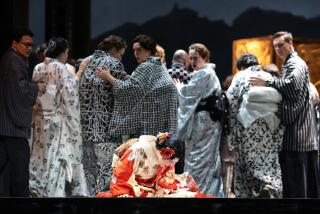THEATER REVIEW : Refined Grand Kabuki at Japan America Theatre
- Share via
The Grand Kabuki managed to be both strikingly theatrical and rigorously anti-dramatic throughout a program of three duets, Friday afternoon at the Japan America Theatre.
Each piece went nowhere with enormous flair, concentrating on displays of emotion and dancing rather than narrative development. Indeed, “Shitadashi Sambaso” had no plot whatsoever--merely two symbolic figures performing a danced benediction.
Manjiro Ichimura II played a female variant of Senzai, the character who represents the exalted, long view of human achievement. In sublime contrast, Mitsugoro Bando IX assumed the title role of the piece: impishly irreverent and obsessed by the comic details of living, but periodically blessing the audience with the holy sound of tiny golden bells.
Where tests of balance dominated many of Senzai’s solos, Sambaso’s capitalized on high-stepping bravado, stylized gesture and such playful motifs as a shrugging motion that would suddenly flip his long sleeves upward and wind them around his arms. Always the divine clown, Mitsugoro executed even the pratfalls of the work as if they held wonderful secrets for viewers to ponder.
Most Kabuki plays with origins in the earlier Noh drama are performed on a proscenium adaptation of the Noh stage. Thus both “Shitadashi Sambaso” and “Shizuhata Obi” took place against the same backdrop: a painted pine tree with two rows of musicians seated in front of it.
*
In the latter piece, Mitsugoro portrayed an earthy boatman who gradually grew sympathetic to a madwoman searching for her kidnaped son. Indeed, this change of attitude formed the only dramatic action in a work focused on physicalizing the full spectrum of the mother’s pain.
The Noh original may offer a heartbreaking resolution missing here--as does Benjamin Britten’s opera, “Curlew River,” adapted from it. But the Kabuki version boasted the presence of Living National Treasure Baiko Onoe VII in a performance of great nobility and restraint.
In a characterization exuding a sense of implacable weight, Baiko’s steady, stylized motion would occasionally yield to a sudden spasm, a stumble even, projected with startling realism. Baiko’s showpiece dances proved equally double-edged, with the music (shamisen, drums, flute and voice) helping sustain the feeling of timeless grief.
Completing the program: the previously reviewed “Kongen Kusazuribiki,” again with Manjiro Ichimura II and Tatsunosuke Onoe II. Faubion Bowers continued to provide enlightened simultaneous translations of the plays for those who braved the endless lines to rent headsets.
More to Read
The biggest entertainment stories
Get our big stories about Hollywood, film, television, music, arts, culture and more right in your inbox as soon as they publish.
You may occasionally receive promotional content from the Los Angeles Times.










